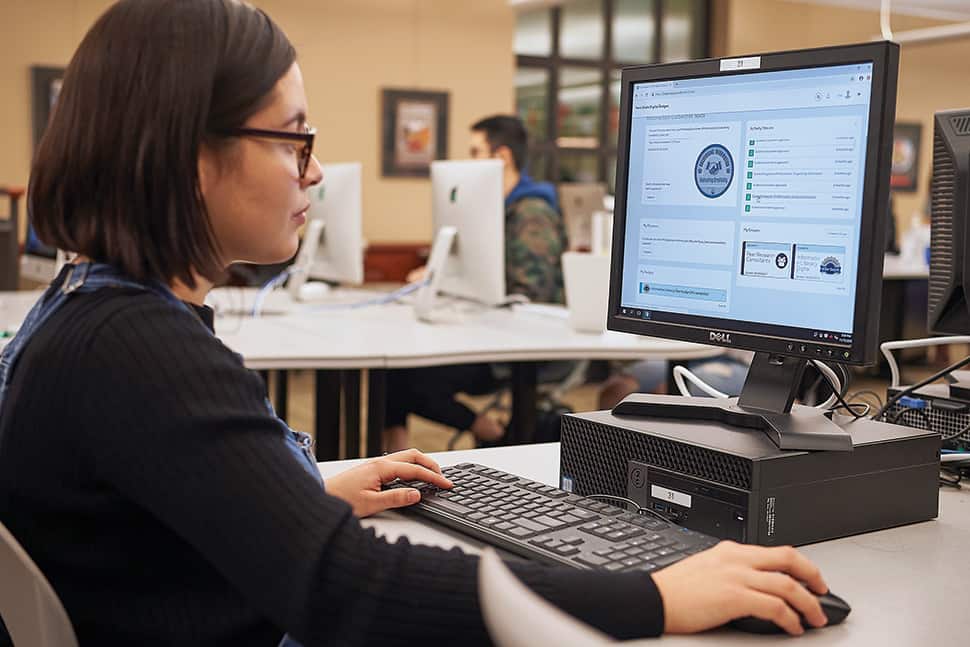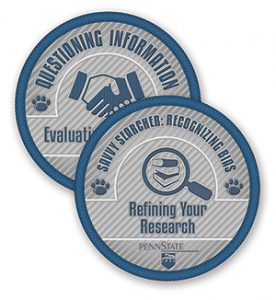
In the last two years, Penn State University Libraries has seen rapid adoption of its information literacy microcredentials among students. Microcredentials—transferable forms of metadata-encoded, performance-based educational credits—are not new; they started gaining traction in academic libraries around 2012. What is different at Penn State is that to help manage the sudden volume of badge submissions, librarians have turned to a new ally: artificial intelligence (AI).
Degrees and professional certifications are valuable, but in many scenarios it’s important and cost effective to have a way to showcase granular skills. Microcredentials—also known as digital credentials or digital badges—are competency-based methods of demonstrated learning that do just that. For instance, a badge may show achievement in Java programming or project management, which can help a candidate land a job promotion or earn a classroom grade.
At Penn State University Libraries, we’re embracing and rethinking microcredentials. We see them as an opportunity to extend our reach and deepen students’ engagement with information literacy—and we see librarians as best positioned to evaluate these essential skills.
Usage of microcredentials at Penn State has recently exploded. From 2013 to 2016, we issued 160 total badges; in academic year 2017–2018, we issued 3,585. We attribute this boom to a broader national awareness of these educational credits and to the school successfully marketing the benefits of the program.
In 2013, when this virtual currency was fairly new, the library conducted a survey of employers from 10 different industries to figure out which information literacy skills would translate best to the job market. Online Learning Librarian Victoria Raish and I used the survey rankings to inform the design of activities for 10 microcredentials to be embedded within general education courses. We created badges for search, inquiry, and organization topics such as keywords, ethics, and citations. Our goal was that, by graduation, students would complete all badges to earn the “über badge,” which could be leveraged in portfolios, résumés, or on social networking sites as a conversation starter with potential employers. Badge earners even have control over what metadata is displayed, such as the date earned, steps required to complete the credential, or actual work submitted to earn it.
 As with nearly all microcredentialing programs, the evidence that learners submit to show they’ve successfully completed a series of steps must be assessed. Quizzes can be automatically graded, but it gets tricky when prompts ask for written responses. In 2017, a team of 14 Penn State employees evaluated more than 10,000 individual badge steps. Giving personalized feedback didn’t easily scale to the large number of submissions, so staffers began to wonder if AI could be a potential or partial solution.
As with nearly all microcredentialing programs, the evidence that learners submit to show they’ve successfully completed a series of steps must be assessed. Quizzes can be automatically graded, but it gets tricky when prompts ask for written responses. In 2017, a team of 14 Penn State employees evaluated more than 10,000 individual badge steps. Giving personalized feedback didn’t easily scale to the large number of submissions, so staffers began to wonder if AI could be a potential or partial solution.
We wanted to keep librarians in the feedback loop but saw a place for AI to triage some aspects of evaluation. Serendipitously, Penn State’s Nittany AI Alliance was offering seed funding for internal projects, so we partnered with the College of Information Science and Technology to develop a tool that integrates human and algorithmic capabilities. We named our AI technology mArI, in honor of Mary McCammon and Mary Katherine Yntema, the first two female computer science faculty members at Penn State.
The technology, which was added to our microcredentialing process in beta in 2018, mainly helps in two ways. For students, a feature called Text on Target uses machine learning to compare drafted responses to previous submissions, so they know if their answers are likely to be scored successfully. For graders, mArI can detect the complexity and grade level of a response, which allows them to focus on providing personalized feedback.
Our hope is that microcredentials and AI will stretch students’ educational dollars and save library staff time. Our story is one of teamwork, partnerships, and an educational technology that has finally arrived.


